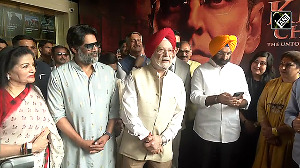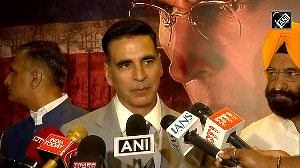Isn't there something significant in the UPI example for all of us to learn from and execute to enable world-scale success for our startups?, asks Ajit Balakrishnan.

"We have to be careful that we don't blow things up," said my stumbling, white-haired friend, long retired from the civil service but who had served in almost all our government's top industrial-policy entities.
Though he can barely speak and almost cannot walk without stumbling, I often tap his fertile brain when policy issues confound me.
I asked him: "Do you think the super-enthusiasm our central and state governments are displaying about start-ups will result in something big for us as a country?"
I posed this question to him because I remember back in the 1990s, when I was passionately running my Internet startup, Rediff.com, Indian government policymakers greeted me with polite but disbelieving faces.
"Of course, tech startups are terrific for the Indian economy," he said, warming my heart, but then his face started looking grim, "but I hope it's not like the 'import substitution' fever, which turned out to be a disaster."
He was referring to a period up to the 1990s, when the government heavily promoted policies aimed at replacing imported goods with domestically produced ones, often through high tariffs and other protectionist measures.
This was blamed for India's slow growth in that period compared to the rest of the world and was abolished as disastrous when Manmohan Singh became finance minister in 1991.
This got me thinking: Could anything trigger a disaster in our tech-startup boom and create a disaster like the import-substitution policies did?
Considering the scale of our enthusiasm for startups, I struggled to imagine whether that was even remotely possible.
For example, a report from the World Economic Forum says, 'In the last 10 years, over 120,000 startups have been registered in India, making it the third-largest startup ecosystem in the world', with only the United States and China higher than us.
Furthermore, practically every IIT (Indian Institute of Technology) and IIM (Indian Institute of Management) has startup incubation centres, and technology parks in many cities.
Then, institutions like Atal Incubation Centres and Nasscom run multiple innovation centres throughout India.
These efforts have even reached schools, with institutions like Atal Tinkering Labs established in about 10,000 schools to foster student innovation.
Reflecting on the impressive scale of India's startup efforts, I wondered whether these could face any major challenges.
After all, I have heard it being said eternally, both by scholars writing in their journal papers and by visiting venture-capital firm partners, that the Indian domestic market for new technology inventions is meagre: The exact words used for this are: "India has a minimal number of early adopters, and this makes life for a tech startup very tough in India."
When I polled more venture-capital experts, I got this for why it's so hard for tech startups in India to achieve any significant scale: First, a large portion of the Indian population is highly price-sensitive (paisa vasool).
Even if they are interested in new technology, affordability is essential.
Then there are cultural factors, they say, like some segments of Indian society may be more cautious about adopting innovative technologies until they are proven and widely accepted.
In other words, they adopt a "wait and see" approach.
And finally, a "value for money" mindset: Indian consumers often prioritise value for money.
This means that even if they are willing to adopt innovative technologies significantly better than existing solutions, they expect these solutions to be priced at "Indian market prices"!
Others asked me: What about the statistics that say 90 per cent of all startups worldwide fail?
How do we plan to help startups deal with this? Do we have enough Indian venture capital to enable this enormous pool of startups to be created in India?
Are our income-tax policies supportive of startup investment?
Listening to all this and having personally experienced some, if not all, of these challenges in my life as an entrepreneur, I can't help but think of an example of hi-tech success in India: Unified Payments Interface (UPI).
When I stroll down lanes in Colaba, where I live, I see fisherwomen from Sassoon Dock pull out their mobile phones, scan the QR code of a street-side fruit seller, and pay for the fruit they buy.
I rub my eyes to confirm that I am not merely imagining this.
The success of UPI in India is a fascinating case study in the intersection of technology, policy, and socioeconomic factors.
It's not just a technological triumph but also a significant achievement in political economy, and its case study has a lot for us to learn from.
It appears that having the National Payments Corporation of India (NPCI), which developed and operates UPI, as a not-for-profit entity established by the Reserve Bank of India and the Indian Banks Association was the key: It's not a private company seeking profit maximisation.
Secondly, UPI is part of a broader 'India Stack', a set of government-backed interoperable digital infrastructure initiatives: Aadhaar, e-KYC, and DigiLocker.
Then, the government actively promoted UPI adoption through various mandates (linking bank accounts to Aadhaar) and incentives (cashback offers and merchant discounts), which also helped.
Then, it helped that UPI is built on an open API (Application Programming Interface) architecture that lets any bank or fintech company create applications that connect to the UPI system, fostering competition and innovation.
The government initially mandated zero charges for UPI transactions below a specific value, making it extremely attractive for merchants compared to card payments involving fees.
All this helped a gradual cultural shift towards digital payments in a country traditionally relying heavily on cash.
Isn't there something significant in the UPI example for all of us to learn from and execute to enable world-scale success for our startups?
Ajit Balakrishnan is devoting his life to unravel the connection between society and technology.
Feature Presentation: Aslam Hunani/Rediff.com












 © 2025
© 2025